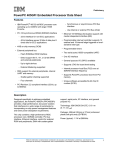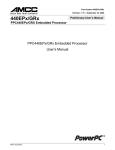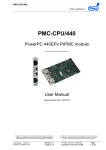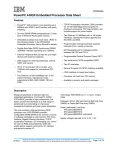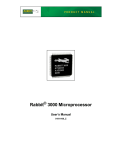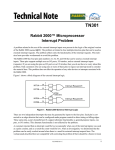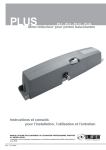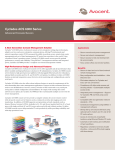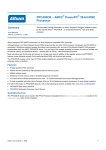Download Preliminary User`s Manual
Transcript
440EPx – PPC440EPx Embedded Processor Revision 1.12 – April 25, 2007 Preliminary User’s Manual 24.2 DMA to PLB3 Controller (DMA2P30) DMA to PLB3 is attached to the 64-bit processor local bus. Table 24-6 lists the DMA2P30 channel assignments in PPC440EPx. Table 24-6. DMA to PLB 3 Channel Assignments Channel Sub-Channel DMA Internal Source Sub-Channel 0 UART 0 Receive Sub-Channel 1 UART 2 Receive DMA External Source Sub-Channel 2 Sub-Channel 3 Channel 0 Sub-Channel 4 Sub-Channel 5 Sub-Channel 6 Sub-Channel 7 Sub-Channel 0 UART 0 Transmit Sub-Channel 1 UART 2 Transmit Sub-Channel 2 Sub-Channel 3 Channel 1 Sub-Channel 4 Sub-Channel 5 Sub-Channel 6 Sub-Channel 7 Sub-Channel 0 UART 1 Receive Sub-Channel 1 UART 3 Receive Sub-Channel 2 Sub-Channel 3 Channel 2 Sub-Channel 4 Sub-Channel 5 Sub-Channel 6 Sub-Channel 7 AMCC Proprietary 625 440EPx – PPC440EPx Embedded Processor Revision 1.12 – April 25, 2007 Preliminary User’s Manual Table 24-6. DMA to PLB 3 Channel Assignments (continued) Channel Sub-Channel DMA Internal Source Sub-Channel 0 UART 1 Transmit Sub-Channel 1 UART 3 Transmit DMA External Source Sub-Channel 2 Sub-Channel 3 Channel 3 Sub-Channel 4 Sub-Channel 5 Sub-Channel 6 Sub-Channel 7 24.2.1 External Interface Signals Figure 24-13 illustrates the external I/Os associated with the DMA controller and the EBC I/Os used during external peripheral transfers. External peripheral and EBC device-paced memory transfers request service from the DMA controller by driving a DMA request line (DMAReq0-3) active. For peripheral mode transfers the DMA controller acknowledges the request and transfers data by asserting a DMA acknowledge signal (DMAAck0-3). In contrast, an EBC device-paced memory-to-memory transfer occurs when the chip select (PerCSn) associated with the memory location is driven active. The timing of PerCSn and the other EBC I/Os is determined by the Bank Access Parameter Register (EBC0_BnAP) for the particular memory location. See External Bus Controller on page 565 for details on EBC configuration and timings. Table 24-7. DMA to PLB3 Controller External I/Os Signal Usage DMAReqn DMA Request, used to request either a peripheral mode transfer or an EBC device-paced memory-to-memory transfer. DMAAckn DMA Acknowledge, instructs an EBC-attached DMA peripheral to transfer data. EOTn[TCn] End of Transfer or Terminal Count. Used to stop the channel when programmed as EOT. When configured as TC, goes active when the channel transfer count register (DMA2P30_CTn) reaches zero. Note: The active level (polarity) of the DMAReqn, DMAAckn, and EOTn[TCn] signals is individually programmable. See DMA to PLB 3 Polarity Configuration Register (DMA2P30_POL) on page 630.. Operating information and timing waveforms are presented generically for active-high signals. 626 AMCC Proprietary Revision 1.12 – April 25, 2007 440EPx – PPC440EPx Embedded Processor Preliminary User’s Manual Figure 24-13. DMA to PLB 3 External Bus Controller Signals DMA to PLB3 Controller DMAReq0 DMAAck0 EOT0[TC0] DMAReq1 PLB DMAAck1 EOT1[TC1] DMAReq2 OPB DMAAck2 EOT2[TC2] DMAReq3 DMAAck3 EOT3[TC3] PerClk PerData0:31 EBC Controlled I/Os PerR/W PerOE PerWBE0:3 DCR Bus Configuration and Status Registers 24.2.2 Functional Overview As a specialized controller, the DMA unit provides system designers and programmers with a highly efficient method of moving data. During any DMA transfer the controller always buffers data read from the source prior to writing the data to the destination. Since many buses, including the internal PLB and the SDRAM interface, provide substantially better performance when bursting data, the DMA controller includes a 32-byte (4 double words) buffer. This buffer is enabled on a per-channel basis by setting DMA2P30_CRn[BEN] and serves to minimize the number of discrete memory transactions. Each of the four DMA channels is configurable for either peripheral or memory-to-memory transfers. 24.2.3 Peripheral Mode Transfers Peripherals are either devices attached to the EBC interface via the DMAReqn and DMAAckn lines, or the internal serial port (UART0). Memory is any address accessible from the PLB, including PLB-mapped PCI address space, SDRAM memory, and memory and memory-mapped devices on the peripheral bus. During a peripheral mode transfer the peripheral requests a DMA transfer by asserting a DMA request line. For UART0, this signal is internal AMCC Proprietary 627 440EPx – PPC440EPx Embedded Processor Revision 1.12 – April 25, 2007 Preliminary User’s Manual to the PPC440EPx, while external peripherals use one of the DMAReqn lines. When the requesting channel has the highest priority of any active channel, the requesting device receives a DMA acknowledge. In the case of external peripherals, the appropriate DMAAckn line is driven to the active state, with the timing specified in the DMA Control Register for the channel (DMA2P30_CRn). There are two types of peripheral mode transfers: peripheral-to-memory and memory-to-peripheral. A peripheralto-memory transfer reads data from a DMA device, while a memory-to-peripheral transfer writes data. In both cases, the peripheral interface never bursts and data is transferred at the width of the peripheral. If the DMA buffer is disabled for the active channel (DMA2P30_CRn[BEN]=0), each peripheral transfer causes a corresponding memory operation. When buffering is enabled during a peripheral-to-memory transfer, data is collected until the 32-byte buffer is full, the peripheral deasserts DMAReqn, a higher priority DMA request becomes pending, or the channel completes. The buffer contents are then written to the target memory as efficiently as possible. If the initial programming of the channel’s destination address register (DMA2P30_DAn) is 32-byte aligned, the buffer is emptied in one burst operation to the target memory. Memory-to-peripheral transfers differ since the amount of data that will be requested by the peripheral is unknown. If the DMA buffer is disabled (DMA2P30_CRn[BEN]=0) a discrete source memory read occurs for each element in the DMA transfer. Since this is inefficient, the buffer should only be disabled for low data rate transfers or when the source memory is FIFO-like, and reads are therefore destructive. When the 32-byte buffer is enabled the controller uses the setting in DMA2P30_CRn[PF] to prefetch 1, 2, or 4 64-bit double words from the source memory. The DMA controller provides data from the buffer until the peripheral deasserts its request, the channel is interrupted by one of higher priority, or the transfer completes. Whenever any of these conditions occurs any unused data in the DMA buffer is discarded. 24.2.4 Memory-to-Memory Transfers The DMA controller can perform either device-paced (hardware-initiated) or software-initiated memory-to-memory transfers. Device-paced memory transfers function identically to peripheral mode transfers, except that a chip select (PerCSn) serves as the DMA acknowledge instead of a DMAAckn output. As with peripheral mode transfers, bursts never occur on the device-paced side of the transaction. Software-initiated memory-to-memory transfers between memories with fixed timings provide the best overall performance. During a software-initiated transfer the DMA controller knows the exact amount of data to be transferred. As a result, when the 32-byte DMA buffer is enabled (DMA2P30_CRn[BEN]=1) the controller uses bursts as much as possible. To ensure the highest bandwidth, source and destination addresses should be aligned on 32-byte boundaries. There are three cases that limit the ability to burst during software-initiated memory-to-memory transfers. Bursting is not possible from the source memory when the source address increment is zero (DMA2P30_CRn[SAI]=0). Similarly, the DMA controller does not burst to the destination when the destination address increment is zero (DMA2P30_CRn[DAI]=0). Finally, the DMA controller cannot burst to or from any address that maps to a devicepaced (EBC0_BnAP[RE]=1) EBC chip select (PerCSn). 24.2.5 Scatter/Gather Transfers Each of the four DMA channels supports scatter/gather transfers. This scatter/gather capability allows the chaining of multiple DMA controller operations within a channel. During a normal DMA operation software must program the control, source address, destination address, and count registers for each transfer. Scatter/gather transfers differ in that these registers are automatically loaded from a linked list data structure in system memory. When a channel completes one transfer the DMA controller loads the next set of configuration values into the channel’s registers and the channel continues with the new programming. 628 AMCC Proprietary 440EPx – PPC440EPx Embedded Processor Revision 1.12 – April 25, 2007 Preliminary User’s Manual 24.2.6 Configuration and Status Registers Table 24-8 lists the DMA2P30 configuration and status registers, each of which is accessed using the mtdcr and mfdcr instructions. As example, the following assembly code writes DMA2P30_CR0 and then reads DMA2P30_SR: #define DMA2P30_CR0 #define DMA2P30_SR mtdcr mfdcr 0x100 0x120 DMA2P30_CR0,r3 r4,DMA2P30_SR ! write r3 to channel 0 control register ! read contents of status register into r4 The DMA configuration and status registers are readable at any time. However, because each register read requires a separate operation, it is not possible to guarantee that the values read from multiple registers correspond to a state that ever existed in the DMA controller. To illustrate, consider software that reads the destination address for channel 0 (DMA2P30_DA0) and then the count for channel 0 (DMA2P30_CT0). If the DMA controller updates the count between these two operations, the values read differ from what is expected. While reads can occur at any time, software must not write the configuration registers for any channel that is currently enabled (DMA2P30_CRn[CE]=1). The only exception is that a channel may be disabled by reading the channel control register, clearing the channel enable bit, and then writing the new value to the control register. Once a channel is disabled, all of its configuration registers may be reprogrammed as desired. Table 24-8. DMA to PLB 3 Controller Configuration and Status Registers Mnemonic DCR Address Access Description Page DMA2P30_CR0 0x0100 R/W DMA to PLB 3 Channel Control Register 0 632 DMA2P30_CT0 0x0101 R/W DMA to PLB 3 Count Register 0 634 DMA2P30_DA0 0x0102 R/W DMA to PLB 3 Destination Address Register 0 634 DMA2P30_SA0 0x0103 R/W DMA to PLB 3 Source Address Register 0 634 DMA2P30_SG0 0x0104 R/W DMA to PLB 3 Scatter/Gather Descriptor Address Register 0 635 DMA2P30_SC0 0x0107 Page DMA to PLB3 Subchannel ID for Register 0 636 DMA2P30_CR1 0x0108 R/W DMA to PLB 3 Channel Control Register 1 632 DMA2P30_CT1 0x0109 R/W DMA to PLB 3 Count Register 1 634 DMA2P30_DA1 0x010A R/W DMA to PLB 3 Destination Address Register 1 634 DMA2P30_SA1 0x010B R/W DMA to PLB 3 Source Address Register 1 634 DMA2P30_SG1 0x010C R/W DMA to PLB 3 Scatter/Gather Descriptor Address Register 1 635 DMA2P30_SC1 0x010F Page DMA to PLB3 Subchannel ID for Register 1 636 DMA2P30_CR2 0x0110 R/W DMA to PLB 3 Channel Control Register 2 632 DMA2P30_CT2 0x0111 R/W DMA to PLB 3 Count Register 2 634 DMA2P30_DA2 0x0112 R/W DMA to PLB 3 Destination Address Register 2 634 DMA2P30_SA2 0x0113 R/W DMA to PLB 3 Source Address Register 2 634 DMA2P30_SG2 0x0114 R/W DMA to PLB 3 Scatter/Gather Descriptor Address Register 2 635 DMA2P30_SC2 0x0117 Page DMA to PLB3 Subchannel ID for Register 2 636 DMA2P30_CR3 0x0118 R/W DMA to PLB 3 Channel Control Register 3 632 DMA2P30_CT3 0x0119 R/W DMA to PLB 3 Count Register 3 634 AMCC Proprietary 629 440EPx – PPC440EPx Embedded Processor Revision 1.12 – April 25, 2007 Preliminary User’s Manual Table 24-8. DMA to PLB 3 Controller Configuration and Status Registers (continued) Mnemonic DCR Address Access Description Page DMA2P30_DA3 0x011A R/W DMA to PLB 3 Destination Address Register 3 634 DMA2P30_SA3 0x011B R/W DMA to PLB 3 Source Address Register 3 634 DMA2P30_SG3 0x011C R/W DMA to PLB 3 Scatter/Gather Descriptor Address Register 3 635 DMA2P30_SC3 0x011F Page DMA to PLB3 Subchannel ID for Register 3 636 DMA2P30_SR 0x0120 R/Clear DMA to PLB 3 Status Register 631 DMA2P30_SGC 0x0123 R/W DMA to PLB 3 Scatter/Gather Command Register 635 DMA2P30_ADR 0x0124 R/W DMA Address Decode Register 636 DMA2P30_SLP 0x0125 R/W DMA to PLB 3 Sleep Mode Register 631 DMA2P30_POL 0x0126 R/W DMA to PLB 3 Polarity Configuration Register 630 24.2.6.1 DMA to PLB 3 Polarity Configuration Register (DMA2P30_POL) DMA2P30_POL is used to set the polarity (active state) of the external DMA I/O signals: DMAReqn, DMAAckn, and EOTn[TCn]. As shown in Figure 24-14, if a bit in DMA2P30_POL is 0, the corresponding signal is active high, otherwise the signal is active low. Whenever any of the EOT polarities are changed (DMA2P30_POL[EnP), software must subsequently clear the corresponding EOT status bits in DMA2P30_SR[TS0:3] before enabling the associated DMA channel. This is necessary to prevent a channel from being disabled because of an incorrect EOT status stored in the status bits. Figure 24-14. DMA to PLB3 Polarity Configuration Register (DMA2P30_POL) 630 0 R0P DMAReq0 Polarity 0 DMAReq0 is active high 1 DMAReq0 is active low 1 A0P DMAAck0 Polarity 0 DMAAck0 is active high 1 DMAAck0 is active low 2 E0P EOT0[TC0] Polarity 0 EOT0[TC0] is active high 1 EOT0[TC0] is active low 3 R1P DMAReq1 Polarity 0 DMAReq1 is active high 1 DMAReq1 is active low 4 A1P DMAAck1 Polarity 0 DMAAck1 is active high 1 DMAAck1 is active low 5 E1P EOT1[TC1] Polarity 0 EOT1[TC1] is active high 1 EOT1[TC1] is active low 6 R2P DMAReq2 Polarity 0 DMAReq2 is active high 1 DMAReq2 is active low 7 A2P DMAAck2 Polarity 0 DMAAck2 is active high 1 DMAAck2 is active low 8 E2P EOT2[TC2] Polarity 0 EOT2[TC2] is active high 1 EOT2[TC2] is active low AMCC Proprietary Revision 1.12 – April 25, 2007 440EPx – PPC440EPx Embedded Processor Preliminary User’s Manual 9 R3P DMAReq3 Polarity 0 DMAReq3 is active high 1 DMAReq3 is active low 10 A3P DMAAck3 Polarity 0 DMAAck3 is active high 1 DMAAck3 is active low 11 E3P EOT3[TC3] Polarity 0 EOT3[TC3] is active high 1 EOT3[TC3] is active low 12:31 Reserved 24.2.6.2 DMA to PLB 3 Sleep Mode Register (DMA2P30_SLP) DMA2P30_SLP enables the DMA controller to enter sleep (low-power) mode and programs the number of PLB clock cycles to wait when the controller is idle before going to sleep. The DMA controller only goes to sleep when no DMA channels are enabled and no configuration or status (DCR) register operations are in progress. Reading or writing any of the DMA control or status register awakens the DMA controller. To enable sleep mode, set DMA2P30_SLP[SME] and CPM0_ER[DMA]. When sleep mode is enabled and the DMA controller becomes idle, the 10-bit idle timer begins counting down from the programmed value. Only the upper 5 bits of the idle counter are programmable; the lower 5 bits are hard coded to 0b11111. Therefore, the minimum granularity of the idle timer is 32 PLB clock cycles. When the counter reaches 0, the controller is placed in sleep mode. Figure 24-15. DMA to PLB3 Sleep Mode Register (DMA2P30_SLP) 0:4 IDU Idle Timer Upper 0–31 Upper 5-bits of the idle timer. 5:9 IDL Idle Timer Lower Hard coded to 0b11111 Lower 5-bit portion of the idle timer. Writing this field has no effect. 10 SME Sleep Mode Enable 0 Sleep disabled 1 Sleep enabled If SME=1, also set CPM0_ER[DMA] to enable the clock and power management logic to put the DMA controller to sleep. 11:31 Reserved 24.2.6.3 DMA to PLB 3 Status Register (DMA2P30_SR) As shown in Figure 24-16, DMA2P30_SR provides status information for each of the DMA channels. Bits in DMA2P30_SR are set in hardware, and can be either read or cleared by software. Clearing is performed by writing a word to DMA2P30_SR containing a 1 in any bit position to be cleared and 0 in all other bit positions. The terminal count status (DMA2P30_SR[CSn]), end of transfer status (DMA2P30_SR[TSn]), and error status (DMA2P30_SR[RIn]) must be cleared for a DMA channel to operate. If a scatter/gather operation generates an interrupt for any of these conditions, the channel pauses until software clears any associated status fields in DMA2P30_SR. AMCC Proprietary 631 440EPx – PPC440EPx Embedded Processor Revision 1.12 – April 25, 2007 Preliminary User’s Manual Figure 24-16. DMA to PLB3 Status Register (DMA2P30_SR) 0:3 CS[0:3] Channel 0–3 Terminal Count Status 0 Terminal count has not occurred 1 Terminal count has been reached Set when the transfer count reaches 0. 4:7 TS[0:3] Channel 0–3 End of Transfer Status 0 End of transfer has not been requested 1 End of transfer has been requested Only valid for channels with DMA2P30_CRn[ETD]=0. 8:11 RI[0:3] Channel 0–3 Error Status 0 No error 1 Error occurred See “Errors” on page 637 for more information. 12:15 IR[0:3] Internal DMA Request 0 No internal DMA request pending 1 Internal DMA request is pending 16:19 ER[0:3] External DMA Request 0 No external DMA request pending 1 External DMA request is pending 20:23 CB[0:3] Channel Busy 0 Channel is idle 1 Channel currently active 24:27 SG[0:3] Scatter/Gather Status 0 No scatter/gather operation in progress 1 Scatter/gather operation in progress 28:31 Reserved 24.2.6.4 DMA to PLB 3 Channel Control Registers (DMA2P30_CR0–DMA2P30_CR3) DMA2P30_CR0–DMA2P30_CR3 are used to configure and enable their respective DMA channels. Before a DMA channel can transfer data, the channel control, source address, destination address, and transfer count registers must be programmed. If a DMA channel is programmed for scatter/gather transfers (DMA_SGC[SSGn]=1) the DMA channel control register is automatically loaded from memory. For additional details, see Scatter/Gather Transfers on page 622. Figure 24-17. DMA to PLB3 Channel Control Registers (DMA2P30_CR0–DMA2P30_CR3) 0 CE Channel Enable 0 Channel is disabled 1 Channel is enabled This field is automatically cleared when the transfer completes or an error occurs. 1 CIE Channel Interrupt Enable 0 Disable interrupts from this channel 1 Enable interrupts from this channel When enabled, interrupts are generated for terminal count, end of transfer, and errors conditions. See DMA Interrupts on page 638. 2 TD In peripheral mode: 0 Transfers are from memory-to-peripheral 1 Transfers are from peripheral-to-memory In device-paced memory-to-memory mode: TD is not used (don’t care) for software-initiated memory-to-memory transfers. 0 Peripheral is at the destination address 1 Peripheral is at the source address 3 632 PL Peripheral Location 0 External peripheral (EBC) bus 1 OPB (UART0) AMCC Proprietary Revision 1.12 – April 25, 2007 440EPx – PPC440EPx Embedded Processor Preliminary User’s Manual PW Peripheral Width/Memory alignment 00 Byte (8 bits) 01 Half word (16 bits) 10 Word (32 bits) 11 Double word (64 bits) memory-to-memory transfers only Transfer width equals peripheral width for peripherals. DAI Destination Address Increment 0 Do not increment destination address 1 After each data transfer increment the destination address as shown in the next column If set to 1 increment as follows: • 1, if the transfer width is a byte (8 bits) • 2, if the transfer width is a half word (16 bits) • 4, if the transfer width is a word (32 bits) • 8, if the transfer width is a double word (64 bit) 7 SAI Source Address Increment 0 Do not increment source address 1 After each data transfer increment the source address as shown in the next column If set to 1 increment as follows: • 1, if the transfer width is a byte (8 bits) • 2, if the transfer width is a half word (16 bits) • 4, if the transfer width is a word (32 bits) • 8, if the transfer width is a double word (64 bit) 8 BEN Buffer Enable 0 Disable DMA 32-byte buffer 1 Enable DMA 32-byte buffer If BEN=0, discrete read and write operations occur for each data transfer. 9:10 TM Transfer mode 00 Peripheral 01 Reserved 10 Software-initiated memory-to-memory 11 Device-paced memory-to-memory 11:12 PSC Peripheral Setup Cycles 0–3 Number of PerClk cycles that the EBC peripheral bus is idle from the last peripheral bus transaction until DMAAckn is active. Used only for the peripheral side of peripheral mode transfers. 13:18 PWC Peripheral Wait Cycles 0–63 DMAAckn remains active for PWC + 1 PerClk cycles. Used only for the peripheral side of peripheral mode transfers. 19:21 PHC Peripheral Hold Cycles 0–7 The number of PerClk cycles from the time DMAAckn becomes inactive until the peripheral bus is available for the next bus access. Used only for the peripheral side of peripheral mode transfers. 22 ETD End-of-Transfer/Terminal Count (EOTn[TCn]) Pin Direction 0 EOTn[TCn] is an EOT input 1 EOTn[TCn] is a TC output ETD must be set to 1 if the channel is configured for software-initiated memory-to-memory transfers. 23 TCE Terminal Count (TC) Enable 0 Channel does not stop when TC is reached 1 Channel stops when TC is reached If TCE=1, it is required that ETD=1. CP Channel Priority 00 Low priority 01 Medium low priority 10 Medium high priority 11 High priority Actively requesting channels of the same priority are prioritized by channel number; channel 0 has the highest priority. See Channel Priorities on page 636 for more information. 26:27 PF Memory Read Prefetch Transfer 00 Prefetch 1 double word 01 Prefetch 2 double words 10 Prefetch 4 double words 11 Reserved Used only during memory-to-peripheral and device-paced memory-to-memory transfers. To enable prefetching it is required that BEN=1. 28 PCE Parity Check Enable 0 Disable parity checking 1 Enable parity checking Enables parity checking for peripheral mode transfers. See “Data Parity During DMA Peripheral Transfers” on page 637. 4:5 6 24:25 AMCC Proprietary 633 440EPx – PPC440EPx Embedded Processor Revision 1.12 – April 25, 2007 Preliminary User’s Manual 29 30:31 DEC Address Decrement 0 SAI and DAI fields control memory address incrementing. 1 After each data transfer the memory address is decremented by the transfer width. If DEC=1, it is required that BEN=0. This field is valid only for peripheral mode transfers (TM=00). Reserved 24.2.6.5 DMA to PLB 3 Source Address Registers (DMA2P30_SA0–DMA2P30_SA3) DMA2P30_SA0–DMA2P30_SA3 contain source addresses for memory-to-memory and memory-to-peripheral transfers. If a DMA channel is setup for scatter/gather transfers (DMA_SGC[SSGn]=1), the associated source address register is automatically loaded from memory. For additional details, see Scatter/Gather Transfers on page 638. The source address must be aligned at the transfer width programmed in DMA2P30_CRn[TW]. Otherwise, the error bit (DMA2P30_SR[RIn]) is set for the channel and no transfer occurs. If the source address increment bit in the channel control register is set (DMA2P30_CRn[SAI]), the address is incremented by the transfer width after each data transfer. In contrast, if the channel is performing a memory-to-peripheral transfer and the address decrement bit is set (DMA2P30_CRn[DEC]=1), the address is decremented by the transfer width after each transfer. Figure 24-18. DMA to PLB3 Source Address Registers (DMA2P30_SA0–DMA2P30_SA3) 0:31 Source address for memory-to-memory and memory-to-peripheral transfers. 24.2.6.6 DMA to PLB 3 Destination Address Registers (DMA2P30_DA0–DMA2P30_DA3) DMA2P30_DA0–DMA2P30_DA3 contain the destination address for memory-to-memory and peripheral-tomemory transfers. When a DMA channel is configured for scatter/gather transfers (DMA_SGC[SSGn]=1), the destination address register is automatically loaded from memory. For additional details see Scatter/Gather Transfers on page 638. The destination address must be aligned at the transfer width programmed in DMA2P30_CRn[TW]. Otherwise, the error bit (DMA2P30_SR[RIn]) is set for the channel and no transfer occurs. If the destination address increment bit in the channel’s control register is set (DMA2P30_CRn[DAI]) the address is incremented by the transfer width after each data transfer. However, if the channel is performing a peripheral-to-memory transfer and the address decrement bit is set (DMA2P30_CRn[DEC]=1), the destination address is decremented by the transfer width after each transfer. Figure 24-19. DMA to PLB3 Destination Address Registers (DMA2P30_DA0–DMA2P30_DA3) 0:31 Destination address for memory-to-memory and peripheral-to-memory transfers. 24.2.6.7 DMA to PLB 3 Count Registers (DMA2P30_CT0–DMA2P30_CT3) DMA2P30_CT0–DMA2P30_CT3 contain the number of transfers left in the DMA transaction for their respective channels when EOTn[TCn] is programmed as a terminal count output. When EOTn[TCn] is programmed as an end-of-transfer input (DMA2P30_CRn[ETD]=0), DMA2P30_CTn continues to count down past zero until EOTn is asserted. 634 AMCC Proprietary Revision 1.12 – April 25, 2007 440EPx – PPC440EPx Embedded Processor Preliminary User’s Manual If a DMA channel is setup for scatter/gather transfers (DMA_SGC[SSGn]=1), the count register is automatically loaded from memory. For additional details see Scatter/Gather Transfers on page 638. The value in the DMA count register is interpreted as the number of transfers of the width specified in DMA2P30_CRn[PW], not the total number of bytes. The maximum number of transfers is 64 K, and each transfer can be either 1, 2, 4, or 8 bytes as programmed in DMA2P30_CR[PW]. The maximum count of 64 K transfers is programmed by writing zero to DMA2P30_CTn. Figure 24-20. DMA to PLB3 Count Registers (DMA2P30_CT0–DMA2P30_CT3) 0:15 16:31 Reserved NTR Number of transfers remaining 24.2.6.8 DMA to PLB 3 Scatter/Gather Descriptor Address Registers (DMA2P30_SG0–DMA2P30_SG3) When a DMA channel is setup for scatter/gather transfers (DMA_SGC[SSGn]=1), the Scatter/Gather Descriptor Address Register (DMA2P30_SGn) contains the memory address of the next scatter/gather descriptor table. Prior to starting a scatter/gather transfer, software must write the address of the channel’s descriptor table to DMA2P30_SGn. Once the scatter/gather transfer starts, DMA2P30_SGn is automatically updated from the descriptor table. For additional details see Scatter/Gather Transfers on page 638. Figure 24-21. DMA to PLB3 Scatter/Gather Desc. Addr. Regs (DMA2P30_SG0–DMA2P30_SG3) 0:31 Address of next scatter/gather descriptor table. 24.2.6.9 DMA to PLB 3 Scatter/Gather Command Register (DMA2P30_SGC) DMA2P30_SGC[SSGn] are the start scatter/gather enable bits for channels 0 to 3. DMA2P30_SGC[EMn] are the corresponding enable mask bits for DMA2P30_SGC[SSGn]. Setting DMA2P30_SGC[EMn] = 1 causes the selected channel to begin a scatter/gather operation, while writing a 0 stops the scatter/gather operation. To start or stop a specific scatter/gather channel, the corresponding DMA2P30_SGC[EMn] bit must be set to 1; otherwise, DMA2P30_SGC holds the previous value. Note that halting a scatter/gather transfer does not stop the transfer currently in progress. Upon completion of a scatter/gather sequence of transfers, the DMA controller clears DMA2P30_SGC[SSGn]. If an error occurs when the DMA controller is reading the scatter/gather descriptor table, DMA2P30_SGC[SSGn] is cleared for the affected channel, and the channel error status bit (DMA2P30_SR[RIn]) is set. For additional details see Scatter/Gather Transfers on page 638. AMCC Proprietary 635 440EPx – PPC440EPx Embedded Processor Revision 1.12 – April 25, 2007 Preliminary User’s Manual Figure 24-22. DMA to PLB3 Scatter/Gather Command Register (DMA2P30_SGC) 0:3 Start Scatter/Gather for channels 0-3. 0 Scatter/gather support is disabled 1 Scatter/gather support is enabled SSG[0:3] 4:15 16:19 To start a scatter/gather operation for channel n, EM[n] must also be set. Reserved Enable Mask for channels 0-3. 0 Writes to SSG[n] are ignored 1 Allow writing to SSG[n] EM[0:3] 20:31 To write SSG[n], EM[n] must be set. Otherwise, writing SSG[n] has no effect. Reserved 24.2.6.10 DMA to PLB 3 Subchannel ID Registers (DMA2P30_SC0–DMA2P30_SC3) The DMA Sub Channel ID is a 32-bit register that contains the 3-bit ID in bits 0–2. These bits are used to allow one DMA channel to support up to eight different peripheral devices. This register’s contents are driven out of the core as primary outputs (O_DMA_subchnl_ID0:O_DMAsubchnl_ID3). External multiplexing uses these output signals to select the request and EOT signals from the active device. The value of this register can also be loaded during scatter/gather operations. Figure 24-23. DMA to PLB3 Subchannel ID Registers (DMA2P30_SC0–DMA2P30_SC3) 0:2 SCID 3:31 DMA Subchannel ID Reserved 24.2.6.11 DMA to PLB 3 Address Decode Register (DMA2P30_ADR) OPB addresses are decoded by the DMA by comparing the most significant nibble of the source or destination address to the contents of the DMA2P30_ADR register. The DMA2P30_ADR register is written by a move to DCR operation. Upon reset, its value is set according to the I_DMA_PGM_dmaadr pins, which are tied high or low by the system designer upon instantiation of the DMA in a system. The 8-bit address compare decode field is implemented in bits 0–7 of the 32-bit register. Figure 24-24. DMA to PLB3 Address Decode Register (DMA2P30_ADR) 0:7 ADRD 8:31 Address decode compare field Reserved 24.2.7 Channel Priorities The priority of DMA transfers is controlled on a per-channel basis by the channel priority field in the channel control register. Table 24-9 shows the different priority settings for DMA2P30_CRn[PW]. Table 24-9. DMA to PLB 3 Transfer Priorities DMA2P30_CRn[CP] Priority Level 0b00 Low 0b01 Medium Low 636 AMCC Proprietary 440EPx – PPC440EPx Embedded Processor Revision 1.12 – April 25, 2007 Preliminary User’s Manual Table 24-9. DMA to PLB 3 Transfer Priorities DMA2P30_CRn[CP] Priority Level 0b10 Medium High 0b11 High These priorities serve two purposes. First, the DMA controller arbitrates among all actively requesting channels and selects the highest priority channel for service. If multiple channels request at the same priority, the arbiter selects the lowest numbered channel for service. DMA2P30_CRn[CP] determines the priority of the internal PLB transactions that the DMA controller uses to read and write data. 24.2.8 Data Parity During DMA Peripheral Transfers When DMA2P30_CRn[PCE] = 1, parity checking is enabled for peripheral mode transfers on channel n. Note: The peripheral bus controller (EBC) does not support data parity checking. 24.2.9 Errors The DMA controller detects and reports three types of errors: address alignment, PLB timeout and slave errors. The DMA controller reports errors through the channel error status bit in the DMA status register (DMA2P30_SR[RIn]). If the error status bit for a channel is set, the channel enable bit (DMA2P30_CRn[CE]) is cleared, disabling the channel. An interrupt signal is also presented to the interrupt controller if DMA2P30_CRn[CIE] is set. See DMA Interrupts on page 638 for more information on interrupt processing. When the DMA controller has multiple channels active, an error may be reported on the current channel which was in actuality caused by a previously active channel. This causes the current channel to have its error status bit set. Therefore, for deterministic error analysis with multiple DMA channels active the PLB slave bus controller’s error status registers (the bus error address register in particular), must be queried to isolate the actual channel which encountered the error. In any case, the channel causing the errors will eventually cause all active channels, including itself, to be disabled. 24.2.10 Address Alignment Error The source address (DMA2P30_SAn) and destination address (DMA2P30_DAn) registers must be aligned to the programmed transfer width (DMA2P30_CRn[TW]).The address alignment rules are outlined in Table 24-10. In addition, when a channel is configured for scatter/gather transfers, the scatter/gather table must be word-aligned. If the source, destination and scatter/gather address registers are not appropriately aligned an error occurs immediately after the channel is enabled. Table 24-10. Address Alignment Requirements DMA2P30_CRn[PW] Setting Required Alignment for DMA2P30_SAn and DMA2P30_DAn 0b00 Byte (8-bit) 0b01 Half word (16-bit) 0b10 Word (32-bit) 0b11 Double word (64-bit) AMCC Proprietary 637 440EPx – PPC440EPx Embedded Processor Revision 1.12 – April 25, 2007 Preliminary User’s Manual 24.2.11 PLB Timeout The DMA controller uses PLB operations to read and write memory. A PLB timeout results if the DMA controller attempts to access a non-existent memory location. This will occur if the source, destination or scatter/gather address registers do not map to valid memory locations. 24.2.12 Slave Errors If the DMA controller detects an error from a PLB slave, it finishes any active read/write pair transfer on the channel and then reports an error. An SDRAM uncorrectable ECC error and an EBC bank protection error are examples of PLB slave errors. 24.2.13 DMA Interrupts Each DMA channel can generate interrupts for end of transfer, terminal count and error conditions. Interrupts from a particular DMA channel are enabled by setting the channel enable bit in the channel’s control register (DMA2P30_CRn[CIE]=1). When an interrupt occurs for a given channel, the DMA controller sends a signal to the Universal Interrupt Controller. For the PPC440EPx’s CPU to take an exception, interrupts from the particular DMA channel must be enabled in the interrupt controller’s interrupt enable register (UIC0_ER). Also, the CPU’s machine state register’s interrupt enable bit must be enabled for the appropriate interrupt type (critical or non-critical), MSR[EE,CE]. See Universal Interrupt Controller on page 219 for more information on interrupt controller processing. For DMA channels with interrupts enabled (DMA2P30_CRn[CIE]=1) and not performing a scatter/gather transfer an interrupt is generated while any of the following are true: DMA2P30_CRn[TCE]=1 and DMA2P30_SR[CSn]=1 DMA2P30_SR[TSn]=1 DMA2P30_SR[RIn]=1 When a channel is performing a scatter/gather transfer, interrupt generation is further qualified by the TCI, ETI and ERI bits loaded from the descriptor table (see Table 24-11). Any of the following conditions cause an interrupt during a scatter/gather transfer when interrupts are enabled for the channel (DMA2P30_CRn[CIE=1]): TCI=1 and DMA2P30_CRn[TCE]=1 and DMA2P30_SR[CSn]=1 ETI=1 and DMA2P30_SR[TSn]=1 ERI=1 and DMA2P30_SR[RIn]=1 For both normal DMA and scatter/gather transfers the interrupt remains active until the appropriate bits are cleared in the DMA Status Register (DMA2P30_SR). In addition, interrupts from a channel performing a scatter/gather transfer cause the channel to pause until the interrupt is cleared. 24.2.14 Scatter/Gather Transfers With a normal DMA transfer it is necessary to program a channel’s control, source, destination, and count registers for each transfer. The scatter/gather capability of the DMA controller provides a more efficient solution for applications that require multiple transactions on a single DMA channel. Instead of individually programming a channel’s registers, software creates a set (linked list) of descriptor tables in system memory. Table 24-11 illustrates the required table format. Table 24-11. Scatter/Gather Descriptor Table Memory Address x (word aligned) 638 Byte 0 (MSB) Byte 1 Byte 2 Byte 3 (LSB) DMA Channel Control Word AMCC Proprietary 440EPx – PPC440EPx Embedded Processor Revision 1.12 – April 25, 2007 Preliminary User’s Manual Table 24-11. Scatter/Gather Descriptor Table Memory Address Byte 0 (MSB) Byte 1 x+4 Source Address x+8 Destination Address x + 12 x + 16 LK TCI ETI Byte 2 ERI Byte 3 (LSB) Count Next Scatter/Gather Descriptor Table Address Table 24-12 details the usage of the bit fields in the scatter/gather table. Table 24-12. Bit Fields in the Scatter/Gather Descriptor Table Bit Mnemonic Description 0 LK Link 0 This is the last descriptor. 1 Fetch next descriptor from address DMA2P30_SGn when the channel completes 2 TCI Enable Terminal Count Interrupt 0 Do not interrupt when terminal count occurs 1 Allow an interrupt when terminal count occurs 3 ETI Enable End of Transfer Interrupt 0 Do not interrupt when end of transfer occurs 1 Allow an interrupt when end of transfer occurs. 4 ERI Enable Error Interrupt 0 Do not interrupt if an error occurs 1 Allow an interrupt if an error occurs To configure a channel for a scatter/gather transfer the DMA Scatter/Gather Descriptor Address Register (DMA2P30_SGn) for the channel is set to the address of the first descriptor table, which must be word-aligned. To begin the scatter/gather transfer, software then writes a start scatter/gather and enable mask to the Scatter/Gather Command Register (DMA2P30_SGC). The DMA controller then reads the descriptor table at address DMA2P30_SGn and updates the DMA controller registers as shown in Table 24-13. Upon receiving the data from the scatter/gather descriptor table, the channel’s terminal count status bit (DMA2P30_SR[TCn]) is automatically cleared. Table 24-13. DMA Registers Loaded from Scatter/Gather Descriptor Table Descriptor Table Entry Register Loaded Channel Control Word DMA2P30_CRn Source Address DMA2P30_SAn Destination Address DMA2P30_DAn Count DMA2P30_CTn Next Descriptor Address DMA2P30_SGn After loading the channel’s registers from the descriptor table, the transfer functions as a normal non-scatter/gather operation. If the channel control word loaded from the descriptor table enables interrupts for the channel (DMA2P30_CRn[CIE]=1), the TCI, ETI, and ERI bits further qualify the generation of interrupts. See DMA Interrupts on page 638 for more information on scatter/gather interrupts. AMCC Proprietary 639 440EPx – PPC440EPx Embedded Processor Revision 1.12 – April 25, 2007 Preliminary User’s Manual If the LK (link) bit was not set the scatter/gather process stops when the current transfer completes. Otherwise, the DMA controller reads the descriptor table at address DMA2P30_SGn and the process repeats. 24.2.15 Programming the DMA to PLB3 Controller Before the DMA controller can transfer data it must be configured, both globally and on a per-channel basis. Global registers include DMA2P30_POL and DMA2P30_SLP. For most applications, these registers should be configured when the DMA controller is initialized. To prevent spurious activity resulting from changing the active level for DMAReqn, DMAAckn, or EOTn[TCn], a channel configuration in tDMA2P30_POL should not be altered when the channel is enabled (DMA2P30_CRn[CE]=1). The channel registers are DMA2P30_CRn, DMA2P30_SAn, DMA2P30_DAn, DMA2P30_CTn, and DMA2P30_SGn. The type of DMA transfer determines which of these registers must be programmed and what causes the channel to start. In all cases,DMA2P30_SR[CSn,TSn, RIn] must be cleared, or the channel will not start. The programming information that follows assumes that the DMA controller is operating in non-scatter/gather mode. For scatter/gather transfers, the channel configuration data must be written into a set of descriptor tables in system memory, as described in Scatter/Gather Transfers on page 638. 24.2.16 Peripheral Mode Transfers DMA peripherals are either devices attached to the EBC interface using the DMAReqn and DMAAckn lines, or the internal serial port (UART0). During a peripheral mode transfer an external peripheral asserts DMAReqn to request a DMA transfer. For metastability protection, DMAReqn is double-latched in the DMA on assertion, and sampled with a single latch on deassertion. 640 AMCC Proprietary 440EPx – PPC440EPx Embedded Processor Revision 1.12 – April 25, 2007 Preliminary User’s Manual Timings on the memory-access portion of peripheral mode DMA transfers are governed by the configuration of the associated memory controller. In contrast, timing during the peripheral portion of the transfer is controlled by DMA2P30_CRn[PSC, PWC, PHC]. The effect of these parameters on peripheral timings is illustrated in Figure 24-25 and Figure 24-26. Although shown as active high, the polarity (active state) of DMAReqn, DMAAckn, and EOTn[TCn] are programmable using DMA2P30_POL . Figure 24-25. Peripheral to Memory DMA Transfers Cycle 1 2 3 PerClk DMAReqn DMAAckn PSC PWC PHC PSC PWC PHC EOTn[TCn] PerData0:31 Data 0 Data 1 PerR/W PerOE PerWBE0:3 PerCS0:5 PerBLast PerAddr02:31 PerReady PerErr Peripheral setup cycles (DMA2P30_CRn[PSC]) provide a delay between any previous operation on the peripheral bus and DMAAckn becoming active. Following the setup time DMAAckn is driven active for (DMA2P30_CRn[PWC] + 1) PerClk cycles, until the rising edge of PerClk immediately before DMAAckn goes inactive. During peripheral-to-memory transfers read data from the peripheral is sampled on the rising PerClk edge where DMAAckn goes inactive. After DMAAckn becomes inactive the peripheral bus is held idle for DMA2P30_CRn[PHC] PerClk cycles. The second transfer in Figure 24-25 illustrates the required DMAReqn timing to prevent a subsequent DMA transfer. For all peripheral mode transfers DMAReqn must be sampled inactive at the end of the last PerClk cycle where DMAAckn is active. The EOTn[TCn] I/O can be configured either as an end of transfer input (DMA2P30_CRn[ETD]=0) or a terminal count output (DMA2P30_CRn[ETD]=1). When programmed as a terminal count output, EOTn[TCn] is asserted in the cycle after DMAAckn became inactive and the channel’s count register (DMA2P30_CTn) reached zero. EOTn[TCn] remains active until the terminal count status bit is cleared in the DMA status register (DMA2P30_SR[CSn]). AMCC Proprietary 641 440EPx – PPC440EPx Embedded Processor Revision 1.12 – April 25, 2007 Preliminary User’s Manual If EOTn[TCn] is configured as an end of transfer input (DMA2P30_CRn[ETD]=0), EOTn[TCn] must be sampled active during the last DMAAckn cycle. If the channel is configured for scatter/gather transfers EOTn[TCn] should be immediately deasserted to prevent the subsequent transfer from ending prematurely. Figure 24-26 shows the required timing. Figure 24-26. Memory to Peripheral DMA Transfers Cycle 1 2 3 PerClk DMAReqn DMAAckn PSC PWC PHC PSC PWC PHC EOTn[TCn] PerData0:31 Data 0 Data 1 BE BE PerR/W PerOE PerWBE0:3 PerCS0:5 PerBLast PerAddr02:31 PerReady PerErr For both peripheral-to-memory and memory-to-peripheral transfers the transfer width (DMA2P30_CR[PW]) must be set to the data bus width of the peripheral. This is because the DMA controller does not pack or unpack data on the peripheral side of transaction. 24.2.16.1 Peripheral-to-Memory Transfer To perform a peripheral-to-memory DMA transfer from an EBC-attached DMA peripheral: 1. Set destination address register (DMA2P30_DAn) to the desired memory location. The address must be aligned to the programmed transfer width (DMA2P30_CRn[PW]), otherwise an alignment error will occur. 2. Program the count register (DMA2P30_CTn) for the number of transfers. 3. Clear the channel’s status bits in the DMA status register (DMA2P30_SR). 4. In the channel control register (DMA2P30_CRn): a. Optionally enable the DMA buffer, BEN=1. b. Optionally enable parity checking, PCE=1. c. Set the destination address increment, DAI=1. d. Set the transfer mode to peripheral, TM=0b00. 642 AMCC Proprietary Revision 1.12 – April 25, 2007 440EPx – PPC440EPx Embedded Processor Preliminary User’s Manual e. Set the peripheral location to external, PL=0. f. Set the transfer direction to peripheral-to-memory, TD=1. g. Enable the channel CE=1. Once the DMA channel is active, the peripheral initiates a transfer by activating the DMAReqn pin for the channel. The PPC440EPx then activates the DMAAckn pin to read data from the peripheral. This continues until either a terminal count or end of transfer condition occurs. 24.2.16.2 Memory-to-Peripheral Transfer To perform a memory-to-peripheral DMA transfer to an EBC-attached DMA peripheral: 1. Set source address register (DMA2P30_SAn) to the desired memory location. The address must be aligned to the programmed transfer width (DMA2P30_CRn[PW]), otherwise an alignment error will occur. 2. Program the count register (DMA2P30_CTn) for the number of transfers. 3. Clear the channel’s status bits in the DMA status register (DMA2P30_SR). 4. In the channel control register (DMA2P30_CRn): a. Optionally enable the DMA buffer, BEN=1, and set the desired prefetch count, PF. b. Optionally enable parity generation, PCE=1. c. Set the source address increment, SAI=1. d. Set the transfer mode to peripheral, TM=0b00. e. Set the peripheral location to external, PL=0. f. Set the transfer direction to memory-to-peripheral TD=0. g. Enable the channel, CE=1. Once the DMA channel is active, the peripheral initiates a transfer by activating the DMAReqn pin for the channel. The PPC440EPx then reads the source memory and subsequently activates the DMAAckn pin to write data to the peripheral. This continues until either a terminal count or end of transfer condition occurs. 24.2.17 Memory-to-Memory Transfers Memory-to-memory transfers can be initiated either by software or by an external device. If initiated via software, the transfer begins as soon as the channel is configured and enabled. When initiated by hardware (also known as a device-paced memory-to-memory transfer), software configures the channel for a memory-to-memory move and transfers begin when an external device places an active request on the channel request line, DMAReqn. 24.2.17.1 Hardware-Initiated (Device-Paced) Memory-to-Memory Transfers To perform a device-paced memory-to-memory DMA transfer: 1. Set the transfer width (DMA2P30_CRn[PW]) to the width of the device-paced memory. 2. Set the source (DMA2P30_SAn) and destination (DMA2P30_DAn) address registers to the desired memory locations. These addresses must be aligned to the programmed transfer width (DMA2P30_CRn[PW]), otherwise an alignment error will occur. 3. Program the count register (DMA2P30_CTn) for the number of transfers. 4. Clear the channel’s status bits in the DMA status register (DMA2P30_SR). 5. In the channel control register (DMA2P30_CRn): AMCC Proprietary 643 440EPx – PPC440EPx Embedded Processor Revision 1.12 – April 25, 2007 Preliminary User’s Manual a. Optionally enable the DMA buffer, BEN=1, and set the desired prefetch count, PF. b. If the device-paced memory is at the source memory location set PL=1. c. Set the source address increment, SAI, and destination address increment, DAI, as desired. d. Set the transfer mode to device-paced memory-to-memory, TM=0b11. e. Enable the channel, CE=1. Once the DMA channel is configured for this mode, the external device initiates a transfer by activating the DMAReqn input. The PPC440EPx then reads the source memory, buffers the data in the DMA controller and then outputs the data to the destination memory address. Transfers continue as long as the controlling device maintains an active signal on DMAReqn and the channel count register (DMA2P30_CTn) is non-zero. To pause a device paced memory-to-memory transfer, the controlling device must deassert DMAReqn one PerClk cycle before the last cycle in the device-paced memory access. 24.2.17.2 Software-Initiated Memory-to-Memory Transfers (Non-Device Paced) To perform a software-initiated memory-to-memory DMA transfer: 1. Set the transfer width (DMA2P30_CRn[PW]) as desired. 2. Set the source (DMA2P30_SAn) and destination (DMA2P30_DAn) address registers to the desired memory locations. These addresses must be aligned to the programmed transfer width (DMA2P30_CRn[PW]), otherwise an alignment error will occur. 3. Program the count register (DMA2P30_CTn) for the number of transfers. 4. Clear the channel’s status bits in the DMA status register (DMA2P30_SR). 5. In the channel control register (DMA2P30_CRn): a. Optionally enable the DMA buffer, BEN=1. b. Set the source address increment, SAI, and destination address increment, DAI, as desired. c. Set the transfer mode to software-initiated memory-to-memory, TM=0b10. d. Enable the channel, CE=1. Once the channel is enable the DMA controller transfers data from source to destination until the channel count reaches zero. Note that memory-to-memory transfers initiated by software do not use DMAReqn or DMAAckn. 644 AMCC Proprietary





















